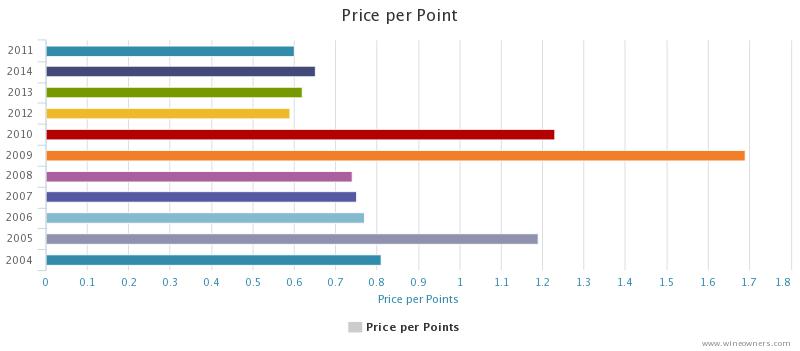If so, it won’t be because of the Commission de Classement. The closing of the Saint-Emilion classification applications took place on June 30 and neither Cheval Blanc nor Ausone returned their copies.
Unlike the left bank classification system of 1855 that is pretty much immutable (with the exception of Mouton’s promotion to Premier Cru in 1973), the St Emilion classification is reviewed approximately once every 10 years, permitting a periodic revaluation of quality and performance. It’s not all been plain sailing; the 2006 reclassification was plagued by accusations of impropriety and was eventually annulled. Consequently, tastings conducted for the 2012 reclassification were outsourced to independent groups from across France to rehabilitate the process.
Cheval Blanc and Ausone, the first St Emilion producers to be awarded Classé A classification in 1954 when it was created, are effectively leaving the classification system.
The Classé A incumbents evidently concluded that the system is no longer sufficiently discriminating to reflect the ranking of their respective properties compared to their peers.
This bombshell threatens to undermine the kudos and financial benefits of promotion to Classé A, and in turn the market pricing potential of those that are elevated. Not to mention it raises questions of the credibility of the St Emilion classification system more broadly.
Is Grand Cru Classé A about to lose its lustre; devalued by ambitious properties busy erecting glitzy edifices? Concrete and stone, some say, matter more than they ought to compared to the brilliance of the wines and their track record.
Or, is Classé A promotion a reflection of the qualitative transformation we see taking place in St Emilion - given the strongly weighted preconditions of a sustained track record of exceptional results and market recognition - and therefore are not elevations thoroughly deserved?
Let’s see what happens over the coming weeks. Can Cheval Blanc and Ausone be courted back into the fold, or is their departure (by omission of submission) a fait accompli? Assuming the latter, perhaps we'll see more promotions next year than we might have otherwise. What effect this all has economically on those producers who attain Classé A classification is now more uncertain than ever.
The crux of the matter here appears to be the U.S. of A. versus the U. of K. Big Bob wades in with the magic three digits (100 points) whilst Mr. Martin offers a much more modest 91 points. Our very own Mr. Martin’s words on this wine are not fit to publish. L. P-B. doffs her cap to her superior with another magic number whilst Jancis sways in a middle sort of division, yet she correctly describes it as famously controversial. So, it’s fair to say: the jury is out!
The early intelligence (thanks go to Bordeaux Index) and the biggest story from their last week’s ten years on tasting is that Cos was the big disappointment (Chateau Margaux was the star performer). Looking at the chart below there appears to be a huge amount more potential downside than upside, the ’09 being more expensive than anything in its peer group and what is the score?? Everyone seems to like the ’16, especially Mr. Martin, not best known and normally associated with magic numbers but attributing it to this vintage with gusto! Likewise, the ’10, not perfection but very highly rated. Both trading at close to £1,700 per 12- without the controversy.
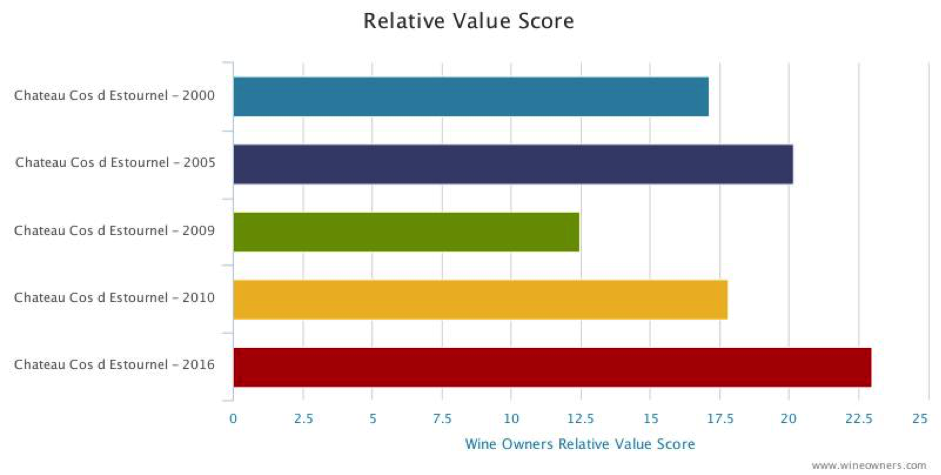
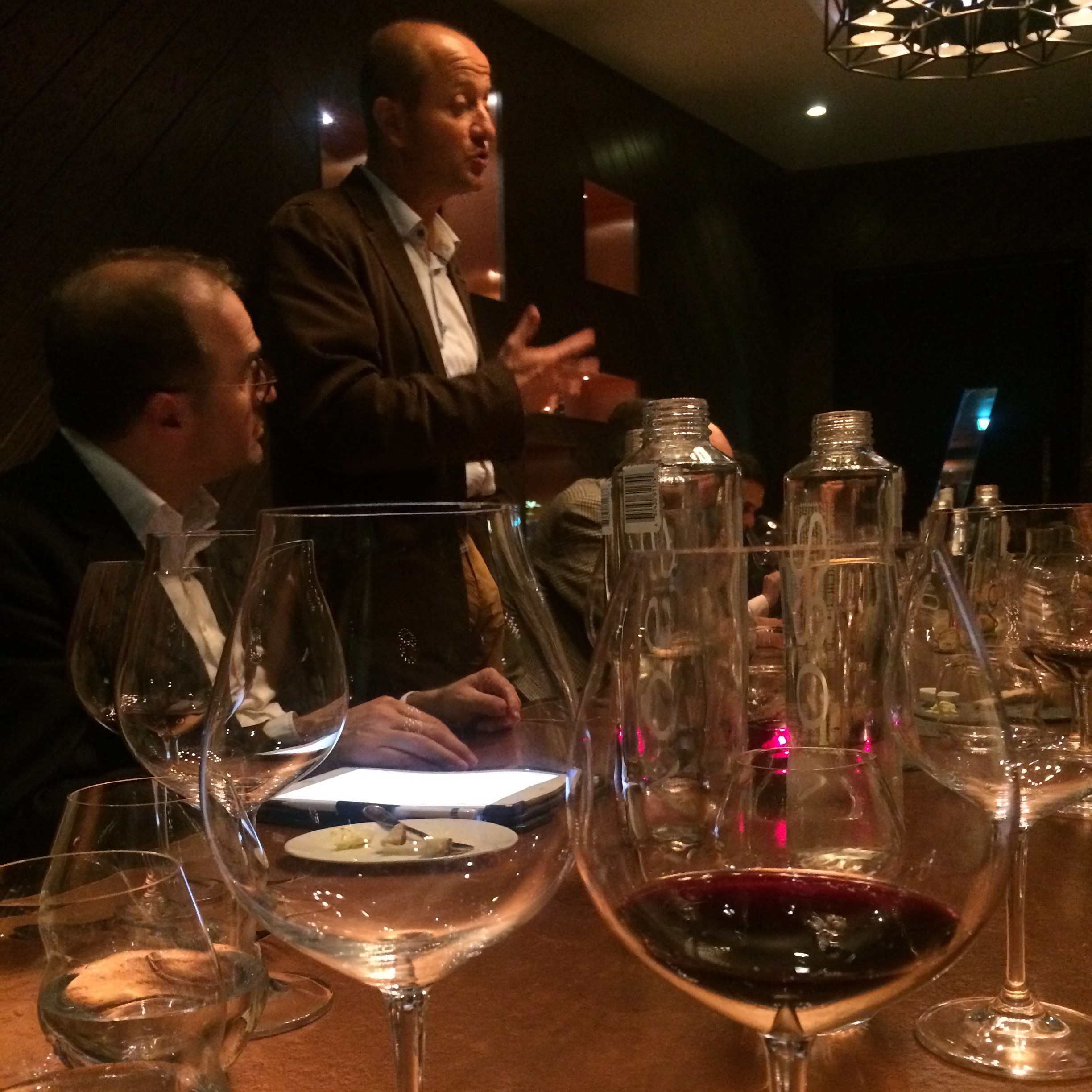
Chateau Lagrange is an unmorcelated parcel to the west of the commune of St Julien, classified as a 3rd Growth in 1855. Owned by Japanese beverage giant Suntory, it’s very much run with a free hand by the local management team.
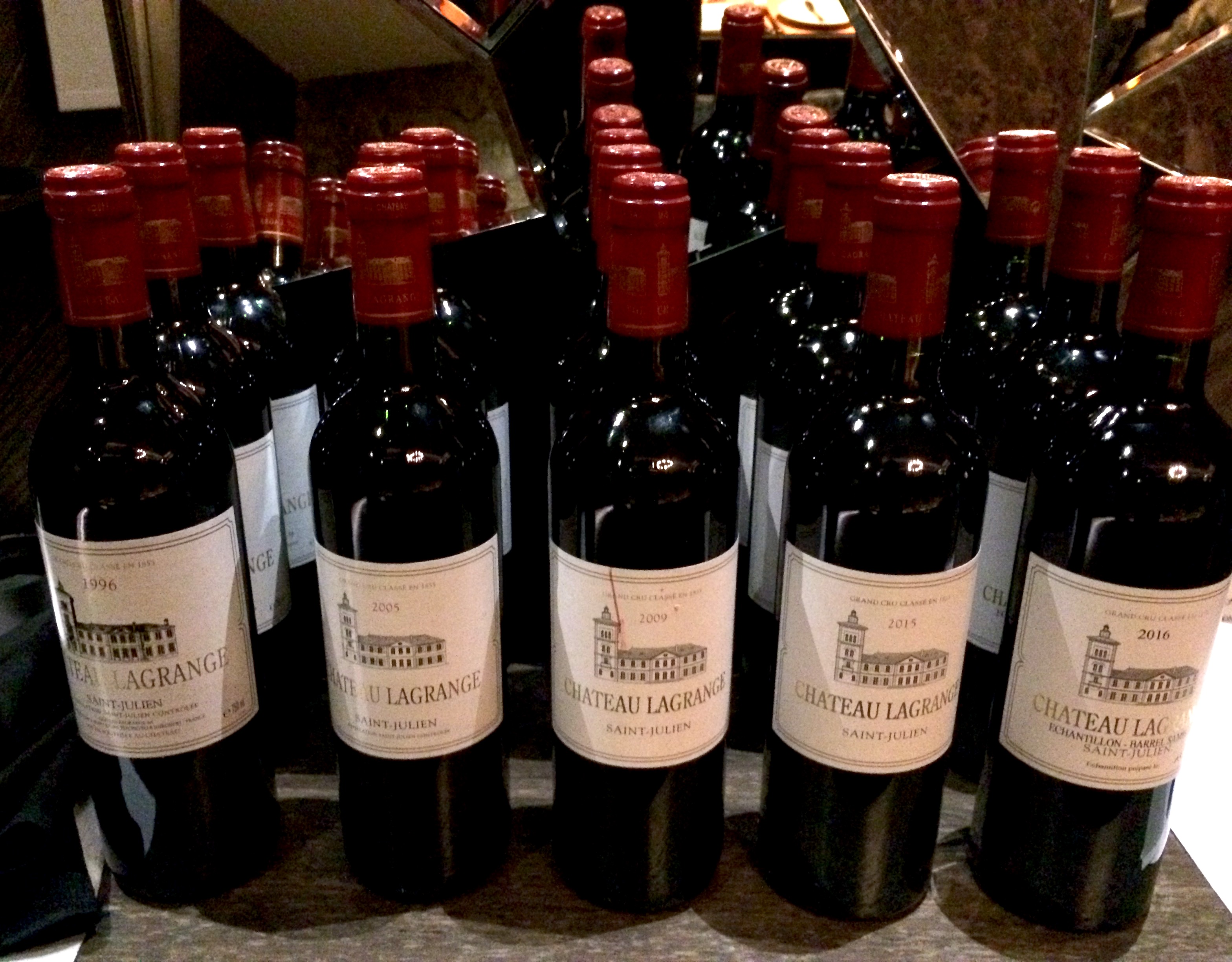
Arums de Lagrange 2016
The tasting kicked off with the estate’s white wine, Les Arums de Lagrange 2016, comprising sauvignon blanc, semillon and a dollop of muscadelle. Arum is a form of hardy lily, and the name is aptly chosen. Les Arums is delightful with a delicate nose and very attractive purity. There’s no trace no heaviness, nor any overt cépage character, due to the gentle handling of the fruit and a balance between barrel fermentation and a period of élevage in steel. It’s drinking beautifully already: there’s clarity to the fruit underpinned by appealing freshness. No need for a Coravin with this one; it’s too tempting to drink the whole bottle!
Chateau Lagrange 2015
A fitting guard of honour for the 2016 vintage that followed. There’s a benchmark cedar nose, with warm and inviting fruit. The initial impression on the nose is of a lush wine, yet the attack is firm, and the fruit is beautifully pure – crystalline. There’s impressive intensity, but at present without the sense of coiled energy of the greatest vintages. Nevertheless this will drink well moderately young, with its warm and inviting nature unlikely to turn taciturn. Very impressive given it had only recently been bottled, a time when wines can pass through an unsociable teenage phase. We wouldn’t be surprised if this gained much more length with time.
Chateau Lagrange 2016
Unsurprisingly with a barrel sample, the nose is on the 2016 is un-evolved, with primary, juicy fruit to the fore. The initial impression at first sip is that the wine is elegant and of medium weight, with a mild savoury streak adding interest. This is an insinuating wine though, whose accomplishments and embellishments become apparent progressively with time in the glass. The tannins are so ripe and silky that their velvety texture cloaks a very considerable underlying structure to the fruit. IPT levels were rather high within the best sectors in 2016, essentially a measure of tannin and colorant from skins, pips and vegetal matter. That substance is very much in evidence chez Lagrange, with a delightful balance that suggests great class. Magnificent.
Chateau Lagrange 2005
We’ve always been fans of those 2005s where the wine making wasn’t unduly extracted, and this Lagrange ticks that box. There’s a dusting of white pepper on the nose, with a blast of kirsch and liquorice. The attack is sweetly fruited, with black ripe cherry dominating the mid palate, and a liqueur-like texture. The finish is heady and visceral. A soulful wine, and very well balanced too. Destined to drink sooner than some other 2005s but with the wherewithal to sustain a long drinking window.
Chateau Lagrange 2009
The nose is extremely fruity yet somehow delivers an impression of being very well integrated. There is enormous intensity to the 2009, with cloves, liquorice, chocolate and blackcurrants, wrapped up in a beautiful texture. The ripeness of the tannins is defining, providing a structure and focus to a bold wine. 27% Merlot, 63% Cabernet Sauvignon. This will need a number of years to properly resolve, by which time the evidently exotic bouquet and textured palate should ensure it develops into a wine reminiscent of 1982 St Juliens.
Chateau Lagrange 1996
Shifting away from young wines with a long life ahead, the 1996 surprised with its maturity. The nose is gamey, with leather notes, and savoury aromatics of smoked meat and sweet wood scents. On the palate there’s a satisfying depth to the wine, in common with other successful 1996s, yet with less noticeable acidity at this stage of evolution than many other top crus classés. Cloves, liquorice and blond tobacco dominate the mid palate before an attractive finish. The freshness of the vintage is seamlessly resolved into the whole. There’s a significant 7% of Petit Verdot in the blend that salt and peppers the 57% Cabernet Sauvignon and 27% Merlot. This is a success offering good value drinking now. If you haven’t already decided on the wine to serve with the Turkey, duck or goose this Christmas, look no further.
by Wine Owners
Posted on 2017-10-09
The first of 3 dinners to taste through 61 red Bordeaux ‘Growths’ classified in 1855, the 2007 vintage had been kindly provided by 2 wine enthusiast brothers who were keen to share this extensive horizontal with fellow members.
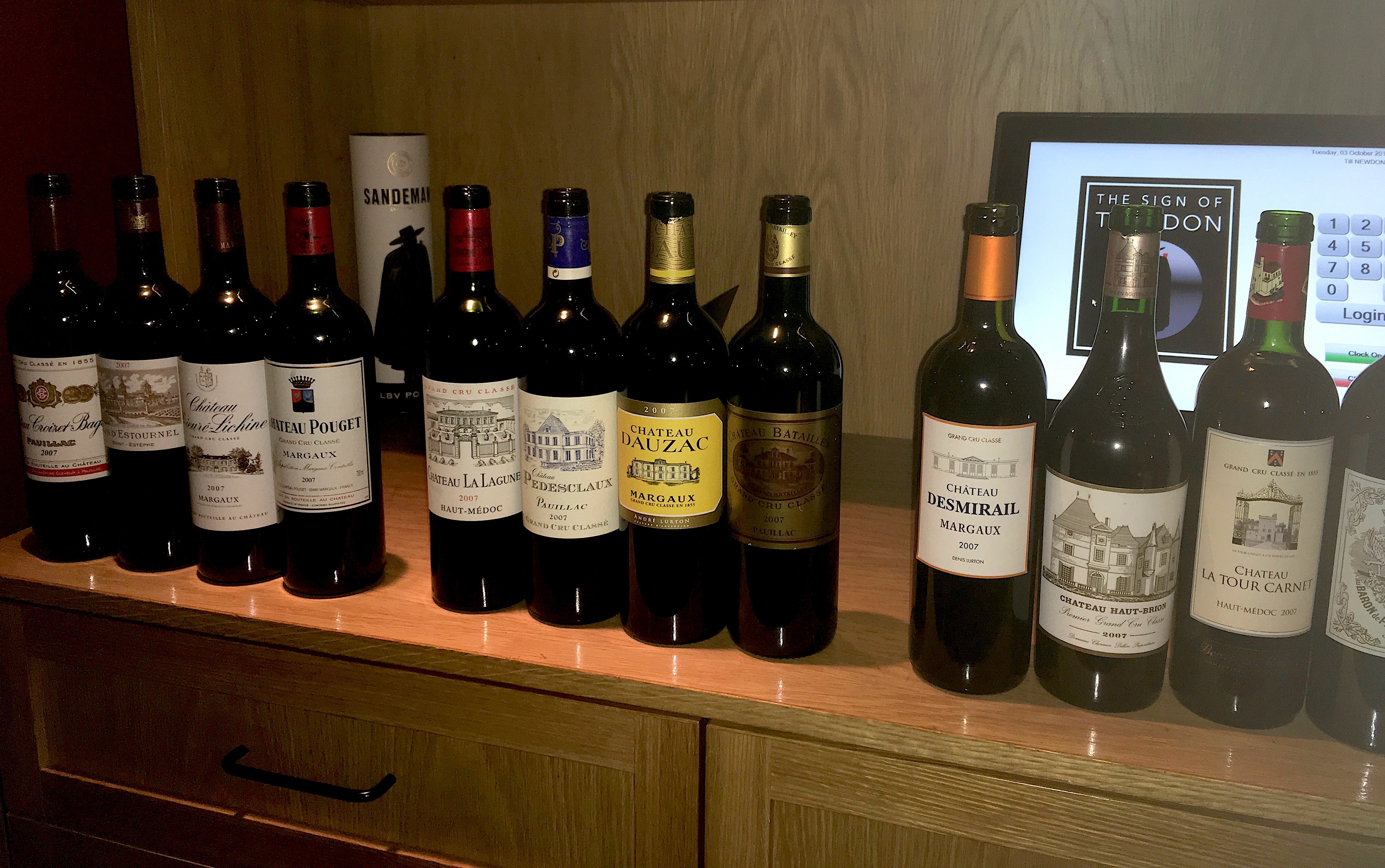
The wines were cleverly organised into suitable flights to accompany each dinner course by Christopher Delalonde, resident Master Sommelier at The Don on St Swithins Lane, ensuring a peak was hit with the glorious venison main course, with further high spots to be enjoyed in the tail-end of supporting wines.
Christopher Delalonde
Given the less than enthusiastic press on the 2007 vintage, the wines showed a remarkable degree of consistency. 2007 was not a vintage to try to force, and the great successes at all levels of affordability and rank were those founded on balance and the natural aromatics of the vintage. Whilst bargains are far and few between, some of the lesser known Crus still represent good value for money. At the top end, the Firsts and most of the Seconds showed their class and the value of their top terroirs.
| Cru | Note | NM Score |
| Croizet Bages, Pauillac, 5th | Fruit forward, spiced nose. Licorice leads the creamy attack, round supple mid palate. Fresh orange zest on the finish provides focus and suggests there's plenty of scope for near-term future development. Still young and promising. | 92 |
| Cos d'Estournel, St Estephe, 2nd | Cool nose, spiced and generously perfumed. Savoury with with a saline element, and a texture reflecting fine, grainy tannins on the already resolved attack. Lifted, sappy, fruity mid palate and a finish that ends on a sweet crescendo. Delicious already, with plenty of future potential, and avoiding the overextraction of 2009/2010 vintages. | 95 |
| Prieuré Lichine, Margaux, 4th | Cool, spiced nose with trademark Margaux perfume. Savoury attack and mid palate, with a blast of licorice. A little obvious and currently a disjointed finish. Mid weight, but this might just be a bit young and yet come together. | 88 |
| Pouget, Margaux, 5th | First time I've ever tasted this Cru? That I can recall. Lovely, sappy nose: a sense of freshness and vitality. Fruity, rounded attack with the dry character of the fruit lending firmness. Mid weight mid palate, with an intriguing orange zest twist to the finish. Balanced and attractive. One to seek out at a bargain price as a household staple for Sunday lunch, given it's anonymity (and relative lack of buyer interest) in the market? | 91 |
| La Lagune, Haut Médoc, 3rd | Perfumed nose betraying it's proximity to Margaux to the North and close to La Garonne. Energetic attack, meaty notes, and lightly spiced blend to create a strong appeal. Only a medium length finish lets it down, but still lots to like. | 90+ |
| Pedesclaux, Pauillac, 5th | Pre the recent renaissance under Lorenzetti, who since 2009 bought 12 hectares next to Lafite and Mouton to enlarge and improve this forgotten Cru. It needed rescuing based on this showing: Licorice infused nose, slightly bright point of attack, nice density but with a bright acidity that isn't integrated and overall paraxodically shows as rather neutral. | 86 |
| Dauzac, Margaux, 5th | Spiced nose, savoury and round. Rather dull and flat in character. Recalls the edgeless wine recipes made by producers for Naked Wine. Think Barry Manilow (unless you like Barry Manilow in which case think of someone else). | 84 |
| Chateau Batailley, Pauillac, 5th | White pepper seasoned nose, griottes and cedar. Attractive cedary attack too with enough acidity to be mouthwatering. Firm, classic claret with enough cut to accompany the foie gras. Being picky, the mid palate came across as hollow on this showing. | 88+ |
| Desmirail, Margaux, 3rd | Quite a neutral nose, on its reserve. Restrained. But the texture shows grainy tannins, offers an elegant intepretation of the appellation, and shows good persistence. The mid palate is dominated by its savoury character at present. Given it was part of the vast Rauzan estate in olden times (together with Rauzan Segla and Gassies), it probably should be offering more than is evident today. | 88 |
| Haut Brion, Pessac, 1st | Liquor-like aromas intermingle with perfume on the nose. There's a stunning, illuminated attack with crystalline red fruit predominating. Superb energy driving into the long, long finish. Primary for now, this is not yet showing any of the unique Haut Brion Graves character one might expect, of charcoal, smoke and stoney minerality. It will come in time - give it 15+ years. Demonstrating once again how good Haut Brion is in off-years (or average years to give 2007 its dues). | 96 |
| La Tour Carnet, Haut-Medoc, 4th | As ambitious as its master, Bernard-Magrez, this is a big wine. A liquory nose leads you in, where the palate is rich, with confit fruit leavened with cedar. Modern but nevertheless quite impressive, it offers value and should settle down with age into a gentler form with a little more refinement. Very recent vintages have pulled back are are a bit more restrained. | 89 |
| Pichon Baron, Pauillac, 2nd | Very creamy nose, anis seeds adding aromatic complexity to the dominant oak influence. Huge cedary attack., sweet fruited mid palate, where the spice and licorice kicks in. Creamy oak influence evident here too. Impressive in its style, but I personally would have preferred more elegance for a Super Second. Yet it's young, needs time, and is an engaging wine for those who are attracted to its powerful form. | 92+ |
| Calon Ségur, St Estephe, 3rd | Always a 'giving' Cru with a good dose of Merlot, the nose immediately shows off its fruit, which is shot through with graphite. Nice intensity to the attack, creamy yet balanced, with an underlying exuberance that's contained. Medium length to the finish which ends a little flat. The ending lets the whole down for now, but may well gain in energy and interest with age. | 92+ |
| D'Issan, Margaux, 3rd | Another estate owned by Lorenzetti, who has been making improvements here for longer than at Pedesclaux. Fruity nose, with gamey notes and a trademark D'Issan salinity. There's a super energy to the mid-palate, fruity then savoury and with great progression. Super-fresh, bright acidity is well integrated into the fruit, and is unforced in its style though I'd prefer a touch more finesse. This should develop very well with time, and should make finer old bones. | 92 |
| Lafite, Pauillac 1st | Creamy nose, black pepper, but very much on its reserve. Superb intensity and an aromatic, floral quality to the fruit. This is defined at this stage of its evolution by refined tannins, is very persistent on the palate and leads into a rich, confit lemon finish. Stunning but terribly young for now. Should be magnificant in 10-20 years. | 96+ |
| Beychevelle, St Julien, 4th | White pepper nose, a fine attack and a round mid palate, nicely integrated but a bit simple overall. For the cash, one expects more. | 88 |
| Kirwan, Margaux, 3rd | Perfumed nose, confit, sticky fruit on a rich attack leading to a thickly textured, disjointed mid-palate. I can't help feel it would be a lot more interesting if it followed the less interventionist approach of D'Issan. Disappointing. | 88 |
| Grand Puy Ducasse, Pauillac, 5th | Perfumed nose, licorice notes, Firm attack, medium weight fruity mid palate with the right amount of freshness to lend lift and definition, and a citric thread driving the finish. Surprisingly good. Perhaps we're so used to the excellence and consistency of Grand Puy Lacoste we're overlooked a 'value' Growth here? | 91 |
| Leoville Barton, St Julien, 2nd | Balanced, classy perfumed nose is a big step up. Very energetic attack leads to a mid palate showing real complexity, mixing savoury notes with licorice and creamy red fruits. Good length, lovely. | 93+ |
| Ducru Beaucaillou, St Julien, 2nd | Cedar and saline nose with a dash of perfume that adds complexity. Smooth entry, svelte fruit on the palate, giving the impression overall of a very polished wine. It's quite possible this is less mute on the palate than was my impression, and that the reserved nature of the fruit augurs well for the future. Somewhat worse for wear by this end point, the note was correspondingly short! | 92+ |
by Wine Owners
Posted on 2017-08-09
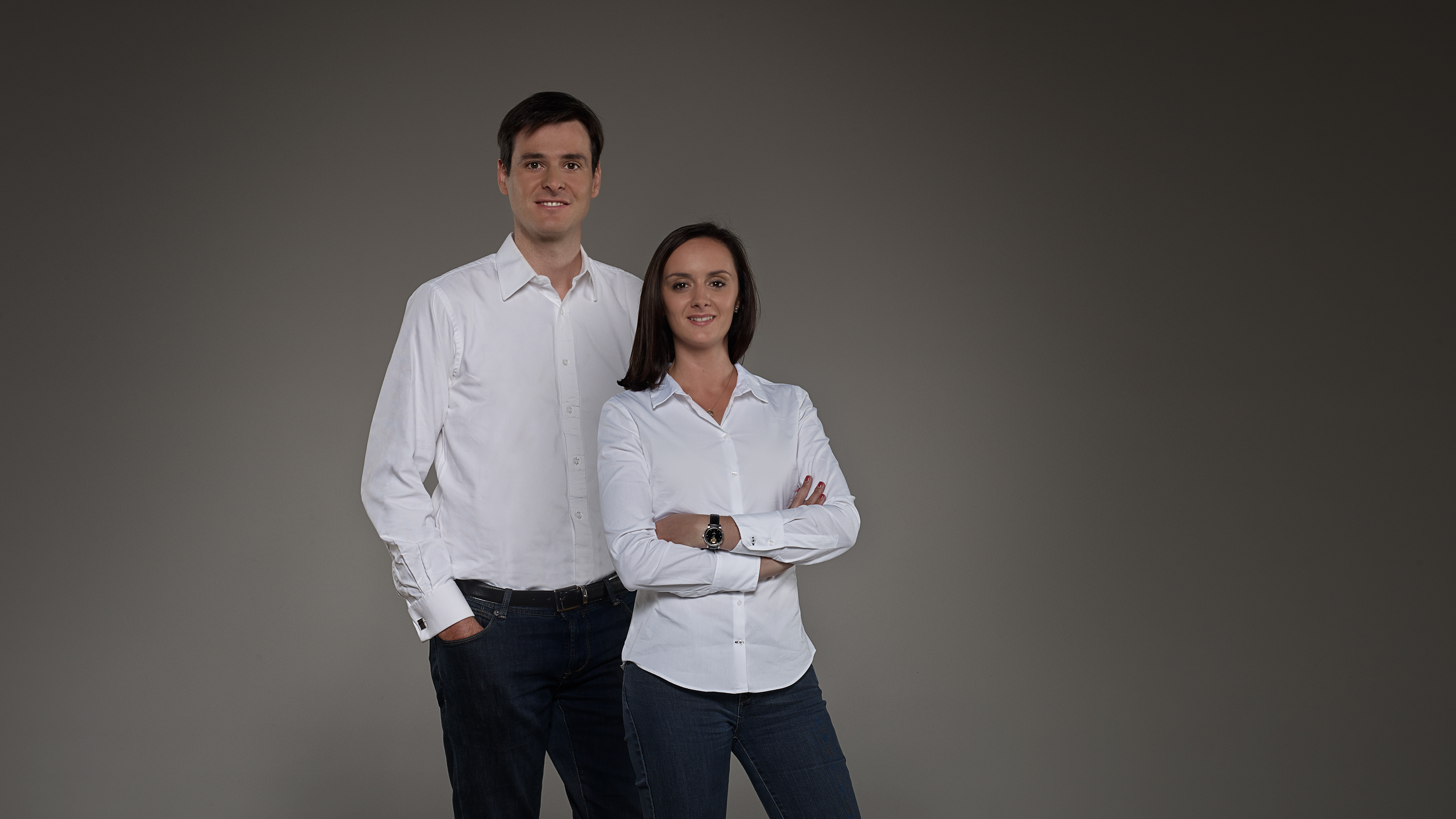
Caroline and Ludovic Decoster from Chateau Fleur Cardinale
Wine Owners: What is your greatest moment/regret as a winemaker?
Caroline Decoster: It’s a little bit sad to start this interview by a regret, but I have to say that we lost 95% of our vineyard in one night last April. It was heartbreaking. We’ve already invested in new machines, called Frostguards, for the end of the year, that will prevent us for this kind of catastrophe, but our main regret is not to have had them before.
WO: In what ways have your wine making changed over the last 10 years.
CD: The global warming has affected our wine making. We are located in the coolest part of the appellation of Saint-Emilion, which means that we have a late ripening terroir. Ripening the berries over the past decades could had been difficult in this part of Saint-Emilion, because of the lower temperatures during October - which is the moment of the year when we usually harvest. But nowadays, due to this global warming, we can benefit from Indian summers year after year, to reach the optimal ripeness effortlessly.
WO: What vintage are you proudest of?
CD: It’s very easy to be proud of a successful vintage. Like in 2010 and 2015, the wine growers were most of all very lucky, thanks to good conditions all year long. But in difficult vintages, all the right decisions that we took in tough moments were decisive to make a good wine in the end. Like in 2014 and 2016 : after months of rain and cold temperatures, the sun came back at the end of the summer, and everybody was so excited to finally have good conditions of ripening, that some vineyards completely de-leafe the bunches, which could be a mistake in some cases: the weeks after that we’d had the hottest temperatures for September since 50 years. We did not de-leafe completely, because we were sure that everything could still happen, and it was the right decision to take.
WO: If you had to define your wines/domaine in one sentence?
CD: Lots of wine owners will say how passionate they are about their wines : but we believe that passion can isolate you and make you blind. That’s why we rather prefer to talk about the « enthusiasm » that we have for our life, a positive and dynamic way of life that we want to share in each glass of Fleur Cardinale, with a lively fruit, and wine with a great energy.
WO: Tell us about your terroir & microclimate, and your approach to winemaking.
CD: First floor is located at the east of Saint-Emilion, on one of the highest points of the appellation, and is planted on clay-limestone soil in the middle of the hillsides. The planting is 75% Merlot with 20% Cabernet Franc and 5% Cabernet Sauvignon. Our aim, vintage after vintage, is to preserve the freshness of the fruit in the glass.
In terms of viticulture, it means for instance that we want each vine to be very healthy, and to express the full potential from its terroir. This year, we’ve been certified High Environmental Value (HEV). This certification is the highest level of a generalised scheme for the environmental certification of farms. It guarantees that the presence of factors of biodiversity (hedges, grass strips, trees, flowers, insects, etc.) is very widespread on our vineyard and that the pressure applied to the environment by our practices (on air, water, soil, climate, biodiversity and landscape) is kept to a minimum.
In terms of vinification, it means that the ageing time in barrels is perfectly well-managed : The wine is aged for 12-14 month maximum, in new French oak barrels. Our coopers provide us with barrels produced exclusively from wood of the 3 most qualitative French forests. A Burgundy toast has been adopted for all our barrels: this kind of toast is realized at a moderate high heat and for an extended period of time, so as to preserve the purity of the fruit and the silky touch of the tannins.
Thank you so much to Caroline for taking the time to answer our questions. All our best wishes to the entire team at Fleur Cardinale!
You can visit the domaine's website here and follow their dedicated work on Instagram, Facebook and Twitter.
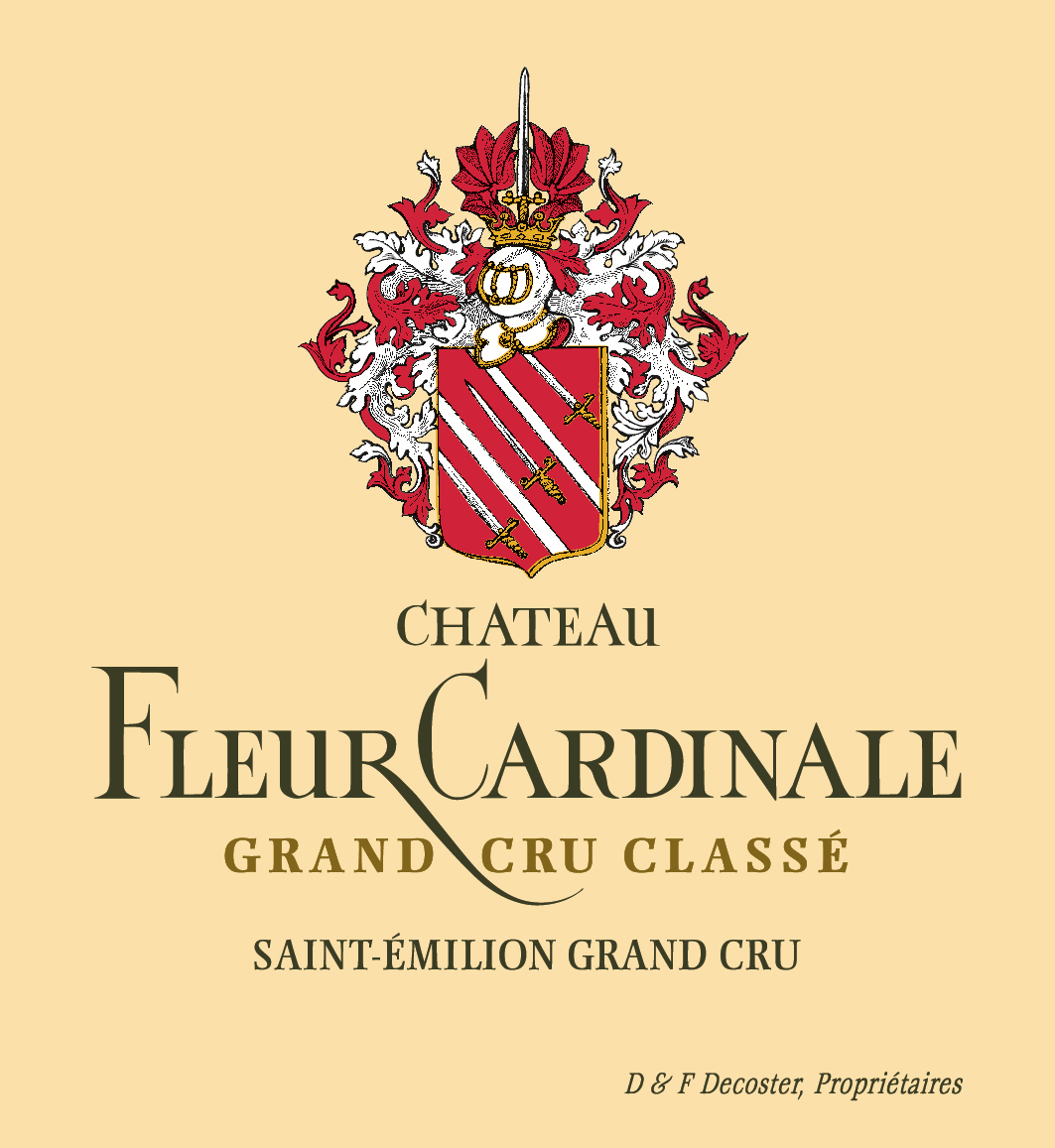
by Wine Owners
Posted on 2017-05-15
The release of 2016 of £775 (12x75cl) is a substantial jump up on the simply marvellous 2015. The previous (in our view better) vintage released at £615 (12x75cl).
So we are looking at a 21% increase YoY. Meanwhile the gap between the two vintages has since closed, with the best offer price of Pape Clément 2015 now trading at £720 (12x75cl).
Not only was 2015 a sound buy for those who jumped in this time last year, it remains an attractive hold, since the release price of 2016 and a rumoured reduction in release quantities attributed to the April 2017 frosts, will lend its price support and push it up to £800+ (2x75cl).
For whom do the frosts toll? Us, the consumer, wine lover, collector…those who buy. The reduction in production volumes now likely for 2017 are difficult for producers, especially in those areas most severely affected, parts of Pessac included. By far the worst affected were those in the lesser appellations on the right bank, St Emilion and Pomerol off the plateaux, and inland in the Medoc. For many of those producers the frosts really were a catastrophe.
As we described here the great estates alongside the Gironde were the least touched by the frost due to the warming effects of the river; those parts of their vineyards affected were on the whole those producing grapes destined for their second wines.
We need to bear in mind too that 2016 production volumes are up 10%-20%, in many instances offsetting the potential losses (subject to a faint possibility of second budding) relating to 2017.
So as consumers, we should sympathise and feel bad for estates such as Pape Clément for their loss of production. We should feel even sadder for producers’ losses in places like Fronsac, Lalande de Pomerol and Castillon, where there will be economic casualties. But it doesn’t mean we will consequently want to buy much more expensive wine.
by Wine Owners
Posted on 2017-04-24
For a detailed overview of the vintage, please see What you need to know about Bordeaux 2016 reds
This year’s Bordeaux 2016 en primeur tasting notes reflect the vintage and its character. You’ll see the same words come up again and again in our tasting notes.
For fruit character, that commonly includes "briar fruit", "cassis" or "blackcurrant" and "sherbetty fruit". Very few showed prune or confit fruit character, and we generally marked these ones down as potentially showing overripe characteristics.
For non-fruit character, it’s "licorice" and "cedar". An Interestingly definitional note: Licorice (or liquorice) is extracted from the root of Glycyrrhiza glabra, a herb whose extract is 50 times sweeter than sugar!
Many of the best wines have a "liqueur-like" refined nose and a similar mouth-feel.
Structurally, a "charge of tannins" is very evident on the attack, often accompanied by a "chewy" finish. This comes from the July/August drought when lack of water led to the plants shutting down and producing correspondingly higher tannins.
The long autumn hang-time with cool nights led to the sense of freshness in the wines. You’ll find lots of wines in my notes that are "mouth-watering", "sappy" and "threaded with acidity".
The finish of the wine is so important when evaluating young, fine (and expensive) wine and this year the finishes are typified by the word "controlled" whilst there was generally very good "insistent" length. It’s that sense of containment and balance on the finish that helps make the best wines so good and sets them apart from the rest.
Further tasting notes will release on the right bank in due course where I did the least tasting, and see these links for what the critics think of St Emilion and Pomerol.
DECANTER - Bordeaux 2016 Right Bank: Anson’s first impression
JANCIS ROBINSON - Bordeaux 2016 : the guide
Picture: Wine Owners Ltd.
SAINT ESTEPHE
| Producer | Score | Favourited | Description | Price bracket | Appellation |
| Cos D'Estournel | 98 | * | Cedary, sweet nose. Then a charge of tannin. Firm fruit, progressively building from a cool mid palate to a powerful, broad finish - rather like a fan opening or a peacock's tail slowly revealing its intricate colours. | £££ | Saint Estephe |
| Montrose | 97 | | Liqueur like nose. Cassis and cedar notes in the attack then sweet mouthwatering, very balanced mid palate. Sweet finish. Very fine. | £££ | Saint Estephe |
| Calon Ségur | 97 | * | Blackcurrant nose, airy, structured attack, liqueur-like texture, then rich summer fruits and a warmer than anticipated finish. Nice firm undercurrent nonetheless as the soft tannins push through and bring needed focus to the finale. | £££ | saint Estephe |
| Le Crock | 95 | * | Refined nose, lovely attack, grainy fruit. Tremendous attack and energy. Dark fruit infused with licorice. Complete, large scaled and satisfying. | ££ | saint Estephe |
| Lafon Rochet | 95 | * | This is fine. Spiced, sweet fruit on the attack and mid palate, a big tannic charge and chewy finish. This is long term, big-scaled and really serious. | ££ | Saint Estephe |
| Chateau Phelan Segur | 93 | * | Svelte, dense, lots of freshness, spiced attack. Soyeux, with a point of freshness at the finish. | ££ | Saint Estephe |
| Cos Labory | 93 | * | Good density and attack. Very good complexity to the fruit. Mid weight. Super length. Quite clearly the best since the superb 1990. | ££ | Saint Estephe |
| Ormes de Pez | 92 | * | Seasoned nose, a touch of cassis and cream, glorious cassis fruit and blackcurrant leaf. Great freshness and zesty finish. | ££ | Saint Estephe |
Pagodes | 92 | | Gentle attack, a sweet flourish and a mouthwatering mid-palate. Attractive, if not the most impressive St Estephe this year. | ££ | Saint Estephe |
| Dame de Montrose | 91 | | Lovely attack, good dry fruit, nice lift and fine finish. | ££ | Saint Estephe |
| Meyney | 93 | * | Liqueur-like in its texture, a super attack of cassis crème. Long, intense, well balanced and super-well integrated. I love St Estepehe in 2016 | £ | Saint Estephe |
| Chateau de Pez | 92 | * | Super-vibrant, a little sweeter than some, but nicely done and a great finish. | £ | Saint Estephe |
| Marquis de Calon Segur | 90 | | Evident structure, quite sweet mid-palate but lots of sap to it too to accompany the ripeness, hence the finish coats the lips with a dollop of cassis jam. | £ | Saint Estephe |
| Capberne Casqueton | 89 | | Savoury, attractive attack with good weight, a noticeable intensity, but just a little less energy for me than 2010. Second best ever vintage of this wine. | £ | Saint Estephe |
| Tronquoy Lalande | 89 | | Briar fruit, quite deep, merlot heavy and correspondingly plush. | £ | Saint Estephe |
| Haut Marbuzet | 88 | | It's fine, but in a veritable constellation of terrific St Estephe performances, this is closer to the back of the classroom. | £ | Saint Estephe |
PAUILLAC
| Producer | Score | Favourited | Description | Price bracket | Appellation |
| Lafite Rothschild | 99 | * | Subtle, elegant, understated. Buffered tannins, very, very complex fruit with an illuminated fringe of acidity. It's an exercise in balance with a firm, insistent finish. | ££££ | Pauillac |
| Mouton | 98 | | Aromatic, perfumed, sensual nose. Lush, huge, spiced with cloves. Powerful and dense. Very fine complex palate, anise seeds. Amazingly well-integrated tannins. | ££££ | pauillac |
| Latour | 97 | | Restrained nose, fruit attack, buffered tannins, complex with an iron infusion and a touch a meatiness, leading to a firm finish. | ££££ | Pauillac |
| Carruades de Lafite | 96 | * | Mouthwatering attack, Covered, voluminous fruit. Powerful, serious wine. Licorice. Very, very long. Best ever. | ££££ | Pauillac |
| Pichon Longueville Lalande | 99 | * | Subdued nose, then a very refined attack, more backward than many, but there's evident intensity of fruit, a wonderful aromatic quality, with great prickly acidity throughout. Not showy, but extremely impressive in its reserved, elemental state. It feels like it could be a legend in the making. | £££ | Pauillac |
| Pontet Canet | 97 | * | Saline, eucalyptus nose, powerful attack. Sweeter than some others. Unctuous but a beautiful balance. The sweet fruit submerges the considerable tannins. Then a sappy, mouthwatering lift. Pure, powerful and in line with the character of the vintage, a firm finish. | £££ | pauillac |
| Pichon Baron Longeuville | 96 | | Vinous nose. Fine attack and mid palate, showing balance and control. Super-refined. Aromatic, characterful and complete. | £££ | Pauillac |
| Lynch Bages | 96 | * | Deep nose, packed with fruit. Energetic attack. A formidable charge of tannins; chewy, bright attack. Settled, calm finish. | £££ | pauillac |
| Petit Mouton | 93 | | Very fine nose, svelte, integrated, balanced powerful, long and large scaled. | £££ | pauillac |
| Chateau Clerc Milon | 96 | * | Seasoned nose, restrained, quite high acidity. Very mouthwatering and dry. Vinous mid palate. Firm, damsons, réglisse, very svelte finish. Liqueur quality of texture. Very refined but not polished or made-up. | ££ | Pauillac |
| Grand Puy Lacoste | 95 | * | Rich and generous nose, with a touch of licorice. Smooth, supremely balanced wine featuring crystalline fruit. As good as 2010. | ££ | pauillac |
| Réserve de la Comtesse | 94 | * | Vinous nose, perfumed with myrrh, delightfully textured and delicious mid palate. It's hard not to fall in love with this. | ££ | Pauillac |
| D'Armailhac | 94 | | Liqueur-like, fine nose. Good attack. Fine thread of acidity. Sweet mid palate and very controlled, sweet, sappy finish. Lots of tannin, very well integrated. | ££ | pauillac |
| Echo (Lynch Bages) | 92 | | Large-scaled, aromatic fruit, nice grip, sappy, dry mid palate. Characterful. | ££ | Pauillac |
| Chateau Duhart Milon | 91 | | Warm, vinous nose. Quite an overt palate. Slightly bitter twist to the fruit. Quite intense. Powerful tannic charge in the mid-palate. Reminds me of the 89s when they were babies. Ambitious. | ££ | pauillac |
| Chateau Croizet Bages | 91 | | Covered, thickly styled fruit, cedary fresh and insistent, long finish. Cedary and good overall balance. | ££ | Pauillac |
| Chateau Lynch Moussas | 90 | | Iron-infused fruit. A little fierce, but likely to settle down with a bit of bottle age. There is proper intensity there and it's certainly 'real' young wine; a bit disjointed but with the key elements in place. | ££ | Pauillac |
| Pedesclaux | 93 | * | Good concentration, fresh, with a taut citric core. Mouthwatering then the dense fruit kicks in towards the end. Very progressive and very good. Retested May 17: Classical and firm, fresh damsons, spicy, sweet. | £ | Pauillac |
| Lacoste Borie | 90 | | Nice density, good weight, freshness and very silky tannins | £ | pauillac |
| Batailley | 90 | | Pretty, confit fruit. Earlier drinking but delicious for what it is. | £ | Pauillac |
| Grand Puy Ducasse | 89 | | At the sweeter end of the spectrum in the vintage context. | £ | Pauillac |
| Griffons | 89 | | Dense and texturally interesting. Liqueur-like, fruity, and a charge of tannins, that perhaps prematurely curtail the finish. | £ | Pauillac |
| Pibran | 87 | | Slightly odd. A bit of fur on the fruit. A little savoury and wild for my taste. | £ | Pauillac |
| Tourelles de Longueville | | | A bit dull. Uninteresting. | £ | Pauillac |
SAINT JULIEN
| Producer | Score | Favourited | Description | Price bracket | Appellation |
| Leoville Las Cases | 96 | | Super aromatic nose. Savoury. Finely crafted fruit, comprising redcurrants, briar and cherry. Cushioned tannins, and a very integrated finish, with an orange-peel lift. | £££ | Saint Julien |
| Ducru Beaucaillou | 95 | | Vinous nose of blackberry leaf and cedar. Bright attack, chewy without a tannic charge of the year seen elsewhere. Very covered in plush fruit, though fresh and with good energy. Blackcurrant and mint. Cushioned tannins. Lovely but perhaps a little polished for so early? | £££ | Saint Julien |
| Chateau Leoville Barton | 95 | * | Lovely firm-fruited attack, intense but not huge. Very fine mid palate Sweet fruited and medium weight. Insistent and elegant. | ££ | Saint Julien |
| Chateau Gruaud Larose | 94 | | Cool reserved nose, controlled, fine attack. Very fine tannins. Beautifully balanced. | ££ | Saint Julien |
| Branaire Ducru | 94 | | Complete wine, great mouth-coating texture. Big but fine tannins. | ££ | Saint Julien |
| Beychevelle | 94 | * | Liqueur-like nose, vivid attack, rich progressive finish but reassuringly controlled. Excellent. | ££ | Saint Julien |
| Leoville Poyferré | 94 | | Cedary, saline nose, big cassis and briar fruit, with a touch of warmth. Controlled progression, super-integrated tannins, then a dry tannic charge kicks in with chewy, fresh, matière. | ££ | Saint Julien |
| St. Pierre | 94 | * | Powerful attack and tannins but a sweet and long mid palate. Complete and long. Much better balance than the over-polished 2015. Much better and unforced in 2016. | ££ | Saint Julien |
| Langoa Barton | 93 | | Round, sweet mid palate and a mouthwatering finish. Charm and character. | ££ | Saint Julien |
| Gloria | 92 | * | Cool nose, fine mid palate, good energy and a citrus lemony finish. | ££ | Saint Julien |
| Talbot | 92 | | A bit bigger on the attack than some, but certainly not too sweet, and although a little unknit at this stage, there's a fine sap to the finish and it could evolve into an excellent Talbot. | ££ | Saint Julien |
| Chateau Lagrange St Julien | 91 | | Cool restrained nose, super charge of tannins, and a sappy finish. A little bit unknit at this stage to be hyper-critical, but the intensity is there, hence the positive score. | ££ | Saint Julien |
| Clos du Marquis | 90 | | This is very good, peppery, reserved nose, mid weight. Crystalline, crunchy fruit. | £ | Saint Julien |
| Moulin Riche | 89 | | Rich, chewy, with a cocktail of cherry and briar fruit. Gives the impression of being more alcoholic than others. Good length. | £ | Saint Julien |
| Petit Lion | 89 | | Liqueur-like and refined on the palate, quite a bit of acidity and right now, not the longest finish. | £ | Saint Julien |
| Lalande Borie | 88 | | Mid weight, sappy and a reasonable finish. 2010 a better prospect at this level. | £ | Saint Julien |
| la Petite Marquise | 88 | | Cassis nose, creamy and field herbs, including anise on the palate. Approachable and well-balanced with an attractive fresh finish, that is nevertheless on the short side. | £ | Saint Julien |
| Croix de Beaucaillou | 88 | | Vinous, liqueur-like nose, sappy, sweet with soft, svelte fruit. Forward. | £ | Saint Julien |
MARGAUX
| Producer | Score | Favourited | Description | Price bracket | Appellation |
| Palmer | 98 | * | Lots of energy, the attack is incredible. 29 ha/ha due to a mildew attack resulting from a miscalculation (too little) of copper treatment on this biodynamic estate. Creamy briar fruit in a mid-weight+ frame. So much more elegant than 2015. Classy firm fruit. Sweet sherbetty mid-palate and an interesting herbaceousness on the finish. Beautiful wine. | ££££ | Margaux |
| Margaux | 96 | | Refined nose, faintly perfumed. Cassis and energetic attack. A less harmonious mid palate than 2015, but still with a at least a good dab of summer pudding emerging with air. More of a sappy character, firm tannins lurking in background but barely surfacing. This could be very good but is somewhat backward today. | ££££ | Margaux |
| Pavillon Rouge | 92 | | Subdued nose, saline. Savoury palate, quite powerful attack. Rather unusual 84% cabernet composition, signaling the ongoing and increasing seriousness of Margaux's second wine, lending some support to its market price. | £££ | Margaux |
| Ego (de Palmer) | 94 | * | Delicious! Croquant fruit, fine lingering finish, Evident purity. | ££ | Margaux |
| Chateau Durfort Vivens | 93 | * | Characterful and grippy. Quite crystalline, crunchy fruit, with black cherry infused mid palate. Chewy finish competes with persistence of fruit on a mid-weight frame. This is different to 2015, that came across as richer and more mineral (iron), but the minerality is still there. Time will tell which is the more satisfying, they are both excellent in their very different ways. Demeter certified this year (French biodynamic certification). | ££ | Margaux |
| Brane Cantenac | 92 | | Rounded, showing as forward in the context of the vintage, back cherry infused mid-palate, lifted by freshness and with a very nice finish. | £ | Margaux |
| Rauzan Segla | 90 | | Very classy as always but it's not 2015. | £ | Margaux |
| Lascombes | 89 | | Nice attack, then mid palate fades away. Maybe just closed? | £ | Margaux |
| Cantenac Brown | 89-91 | | Very nicely balanced, mid weight, not a patch on the 2015. Retasted May 17: Ripe, progressive, spiced and very energetic. This has come on leaps and bounds in 6 weeks since previous tasting. | £ | Margaux |
| Prieuré Lichine | 88 | | Good energy, just lacking character. | £ | Margaux |
| Malescot St. Exupery | 88 | | I worry that there's a bit of a hole in the middle of the palate. | £ | Margaux |
| Kirwan | 88 | | OK, but not as exciting as the rather good 2015. | £ | Margaux |
| D'Issan | 88-91 | | A bit stalky? Not a patch on the marvelously saline 2015. Retasted May 17: lifted and fine. | £ | Margaux |
| Ferriere | 87 | | I love this Chateau for its direct character blending ripe fruit with a classic mould. I'm afraid 2016 isn't one of those vintages I can recommend. You'd be best looking backwards at least 5-10 years for value for money drinking. | £ | Margaux |
MOULIS EN MEDOC
| Producer | Score | Favourited | Description | Price bracket | Appellation |
| Mauvesin Barton | 92 | * | Superb texture and good length | £ | Moulis en Medoc |
| Chasse Spleen | 92 | * | Liqueur-like texture, solid mid-palate and a fine finish. Very good indeed, and this should be a sensible buy as it always performs in the secondary market. | £ | Moulis en Medoc |
LISTRAC
| Producer | Score | Favourited | Description | Price bracket | Appellation |
| Forcas Borie | 89 | | Superb, fleshy merlot. A lovely near-term wine that should drink on release but has the stuffing to last. A surprise and another good showing for Moulis in 2016. | £ | Listrac |
MEDOC
| Producer | Score | Favourited | Description | Price bracket | Appellation |
| Les Grands Chenes | 91 | * | Juicy, fruity nose. Liqueur texture in the mouth with a controlled, fresh, mouthwatering finish. Young vines on what Bernard Magrez describes as a very impressive terroir with a little bit of gradient to it. This is not at all what I was expecting: classical and quite fine for what it is. | £ | Medoc |
| Goulée | 88 | | Quite rich, warm inviting nose, not the longest. | £ | medoc |
| Chapelle de Potensac | 87 | | Savoury nose. Approachable and easy, a certain density notwithstanding, then savouriness on the mid palate and a nice bright finish. Far less serious than Potensac but does that make it any the worse? | £ | Medoc |
| Tour de By | 86 | | No | £ | Medoc |
| Tour St Bonnet | 86 | | No | £ | Medoc |
| Potensac | 86 | | Aromatic attack, a tannic charge and a slightly rustic finish. This is an agitated wine. Big chewy end-game. | £ | Medoc |
PESSAC LEOGNAN
| Producer | Score | Favourited | Description | Price bracket | Appellation |
| Mission Haut Brion | 97 | * | Vinous. Round, inviting nose. Aristocratic, juggling dense, firm fruit and a mid-weight+ stature. Fresh mid palate, mouthwatering, a fine thread of acidity coaxes the wine into a long, lingering finale. More approachable than Haut Brion and today all the better for it. | ££££ | Pessac-Leognan |
| Haut Brion | 95 | | Floral notes precede a cool nose of ripe fruit. On the palate the fruit is firm, a little more withdrawn at first than MHB, showing a touch of oak, but the tannins are super-fine. Cool finish despite the obvious lurking size of the wine. Should show more in the future, for now probably quite impressive, and elemental just like 2015 was, not obviously showy. In terms of ranking I's suggest more like 1998 than 1989, and a notch or two below their super-serious and intense 2015. My guess is the quality of the Cabernet Franc last vintage was a step up. | £££ | Pessac-Leognan |
| Carmes Haut Brion | 95 | * | Firm, proper and mouthwatering from partial whole bunches. Very good length. Classy and a standout in Pessac at this level. | ££ | Pessac-Leognan |
| Domaine de Chevalier | 94 | * | Lightly seasoned nose. Firm, fruit, bright aromatic mid palate and finale. Sherbetty and refreshing. Fine tannins. Nicely judged weight. | ££ | pessac-Leognan |
| Clarence de Haut Brion | 90 | | Fruity accessible nose, touch of white pepper. Textured entry allied to a lightness of feel, then a touch of warmth and caramel on the finish. | ££ | pessac-Leognan |
| La Chapelle de La Mission Haut-Brion | 90 | | Vinous, fine tannins, crystalline fruit, and a licorice twist towards the back of the mid palate. Mid weight and delicious. | ££ | Pessac-Leognan |
| Pape Clément | 90 | | I fell in love with Pape Clément last year. It had such exceptional balance, lift and class. The terroir truly expressed itself combined with a velour quality to the fruit and great definition thanks to its freshness. 2016 is a step backwards, with hints of over-ripeness within the rich fruit, and (for me) missing a sense of place. | ££ | pessac Leognan |
| Malartic La Graviere | 91 | * | Superb, mid weight and moorish claret with gently sweet mid palate. | £ | Pessac-Leognan |
| La Louviere | 89 | | Good mid weight, with some intensity and charm | £ | pessac-Leognan |
| Esprit de Chevalier | 89 | | Aromatic character, present tannins and graves like dry finish. | £ | Pessac-Leognan |
| Solitude | 88 | | Mid weight and nicely balanced | £ | pessac-Leognan |
| Espault Martillac | 88 | | Padded savoury fruit. | £ | pessac-Leognan |
| Chateau Carbonnieux | 88 | | A bit rustic | £ | Pessac-Leognan |
SAINT EMILION
| Producer | Score | Favourited | Description | Price bracket | Appellation |
| Cheval Blanc | 96 | | Subdued nose, stony and earthy. Very fine mid palate, progressive, aromatic attack, juicy dark licorice and spiced finish. | ££££ | Saint Emilion |
| Figeac | 99 | * | Perfumed nose with jasmine. Energetic attack. Cedary mid palate. Fresh pithy attack. Then chewy bitter, dark cherry conclusion. This is excellent. A bit less of an eager labrador than 2015, it misses the rich summer pudding quality of last year but has greater elegance and is nigh on perfect. | £££ | Saint Emilion |
| Petit Cheval | 91 | | Liqueur textured elegance, leading to a dark, slightly pruney finish | £££ | Saint Emilion |
| Quintus | 91 | | Sweet fruited nose, good volume, nicely done. | ££ | Saint Emilion |
| Quinault L'Enclos | 95 | * | Great fruity nose, very aromatic. Lovely liqueur like mouth feel on a river of flavour. Effortless and fine. Highly recommended. | £ | Saint Emilion |
| Corbin | 93 | * | Quite fat, red fruit predominate, super intensity, quite creamy. Bramble and sloe. Very good. | £ | Saint Emilion |
| Destieux | 92 | * | Liqueur eau de vie nose, character and energy, good intensity and a properly chewy finish. This will be good value. | £ | Saint Emilion |
| Fombrauge | 89 | | Good intensity, tannic charge and grainy texture, with a slightly loose finish | £ | Saint Emilion |
| Le Dragon de Quintus | 89 | | Fruity nose, firm fruited palate. | £ | Saint Emilion |
| Labergorce | 87 | | Savoury, some intensity, cherry finish but slightly rustic | £ | Saint Emilion |
| Saintayme | 87 | | Powerful, lifted attach, with a very firm, slightly bitter mid-palate. (Was this a bad tasting moment of mine?) | £ | Saint Emilion |
| La Dominique | 87 | | Middle of the road, nothing to complain about - or to get excited about. 2015 considerably better. | £ | Saint Emilion |
POMEROL
| Producer | Score | Favourited | Description | Price bracket | Appellation |
| Vieux Chateau Certan | 97 | *
| Reserved nose, with a lovely infusion of eau de vie. There is a very substantial tannic charge in the mid palate, with plenty of intense dark, covered fruit and licorice to compete. Impressive but my guess is that will be a pretty backward wine for years to come. | £££ | Pomerol |
| Eglise Clinet | 95 | | Intense, firm, backward, impressive. | £££ | Pomerol |
| Conseillante | 95 | | Seasoned nose, cool. Creamy and dense cassis fruit, the attack is rather aromatic. The expansive mid palate is spiced. Chewy but soft and silken tannins on the progressively rich finish. Rich yet there's a crystalline aspect; a control and focus that constrains the eager fruit. | £££ | Pomerol |
| l'Evangile | 92 | | Dark hued and correspondingly darker flavours than many in 2016. Cassis, mulberries and a hint of plum. There's a certain freshness that duels with a little warmth on the finish, like a welcome current of air alleviating an otherwise hot day. Those who enjoy bigger wines will attract to L'Evangile. | £££ | Pomerol |
| Petit Villages | 95 | *
| Cedar nose, cool. Liqueur like texture, the fruit infused with eau de vie. Super charge of tannins, racy balanced and elegant. Is this the best Petit-Villages ever? | ££ | pomerol |
| Vray Croix de Gay | 92 | *
| Reserved, elegant with a fine finish. Good vinosity. | ££ | Pomerol |
| Chateau Rouget | 92 | | Good definition, intensity and freshness | ££ | Pomerol |
| Petite Eglise | 90 | | An exercise in restraint for the vintage, but for now it presents as a bit angular. (Was this a bad tasting moment of mine?) | £ | Pomerol |
| Chateau Beauregard | 89 | | Nice control on he finish though comes across as a little monolithic | £ | pomerol |
| Chateau La Pointe | 88 | | Big attack, sticky ripe fruit, quite monolithic | £ | Pomerol |
LALANDE DE POMEROL
| Producer | Score | Favourited | Description | Price bracket | Appellation |
| Siaurac | 92 | * | Classy, balanced, controlled, rich and delicious. | £ | Lalande de Pomerol |
| la Chenade | 88 | | Mid weight, sappy, pure, grippy bitter fruit. Good length and satisfying finish. What I don't get is a specific character. | £ | Lalande de Pomerol |
| Cruzelles | 87 | | Bitter cherry, a little drying in the mid palate ((Was this a bad tasting moment of mine?) | £ | Lalande de Pomerol |
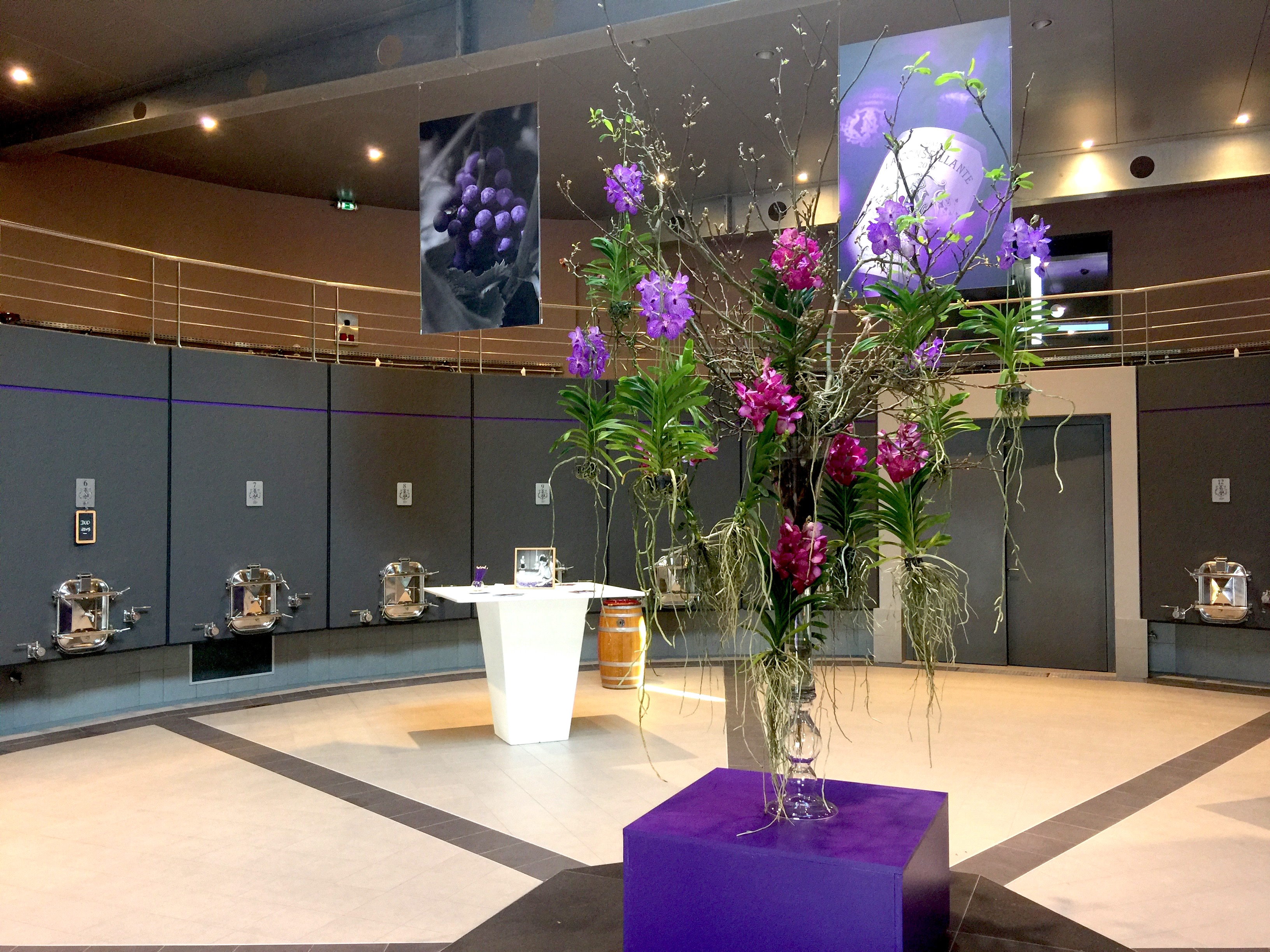
Picture: Wine Owners Ltd.
by Wine Owners
Posted on 2015-10-29
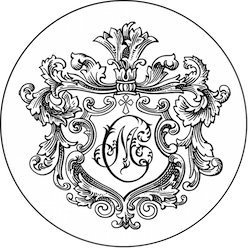
OWNER
Chateau Montrose
APPELLATION
Saint-Estephe
BLEND
Bordeaux Red Blend
AVERAGE SCORE
95/100
CRITICS REVIEW
'This is considered to be among the greatest vintages ever made in Montrose, right up with the 1929, 1945, 1947, 1959, 1961, 1989, 1990 and 2009. Harvest was October 15 to 17. The wine has really come on since I last tasted it, and it needs at least another 10 years of cellaring. The blend was 53% Cabernet Sauvignon, 37% Merlot, 9% Cabernet Franc and 1% Petit Verdot. The wine is opaque black/blue, with an incredible nose of blueberry and blackberry liqueur, with hints of incense, licorice, and acacia flowers. Tannins are incredibly sweet and very present. The wine is full-bodied, even massive, with great purity, depth and a finish that goes on close to a minute. This is a 50- to 75-year-old wine that will repay handsomely those with good aging genes.'
100 points - Robert Parker
View all scores & reviews
PRODUCER PROFILE
Area under vines 95 hectares
Soils deep, large size gravel with sand and a small amount of clay
Average age of the vines 40 years
Production 400 000 bottles a year
Planting density 9000 vines/ha
Ageing in 60% new oak barrels for 16 to 18 months
View full profile
MARKET PRICE

by Wine Owners
Posted on 2015-09-02
Chateau Pontet Canet - 2009
Region: Bordeaux (Medoc)
Appellation: Pauillac
Classification: Cinquieme Cru Classe
'An amazing wine in every sense, this classic, full-bodied Pauillac is the quintessential Pontet Canet from proprietor Alfred Tesseron, who continues to reduce yields and farms his vineyards biodynamically - a rarity in Bordeaux. Black as a moonless night, the 2009 Pontet Canet offers up notes of incense, graphite, smoke, licorice, creme de cassis and blackberries. A wine of irrefutable purity, laser-like precision, colossal weight and richness, and sensational freshness, this is a tour de force in winemaking that is capable of lasting 50 or more years. The tannins are elevated, but they are sweet and beautifully integrated as are the acidity, wood and alcohol (which must be in excess of 14%). This vineyard, which is situated on the high plateau of Pauillac adjacent to Mouton Rothschild, appears to have done everything perfectly in 2009. This cuvee should shut down in the cellar and re-open in a decade or more. Anticipated maturity: 2025-2075.' - 100 points RP

Chateau Cos d'Estournel - 2009
Region: Bordeaux (Medoc)
Appellation: Saint-Estephe
Classification: Deuxieme Cru Classe
'One of the greatest young wines I have ever tasted, the monumental 2009 Cos d'Estournel has lived up to its pre-bottling potential. A remarkable effort from winemaking guru Jean-Guillaume Prats and owner Michel Reybier, this blend of 65% Cabernet Sauvignon and the rest Merlot (33%) and a touch of Cabernet Franc (2%) was cropped at 33 hectoliters per hectare. It boasts an inky/black/purple color along with an extraordinary bouquet of white flowers interwoven with blackberry and blueberry liqueur, incense, charcoal and graphite. The wine hits the palate with extraordinary purity, balance and intensity as well as perfect equilibrium, and a seamless integration of tannin, acidity, wood and alcohol. An iconic wine as well as a remarkable achievement, it is the greatest Cos d'Estournel ever produced. It is approachable enough at present that one could appreciate it with several hours of decanting, but it will not hit its prime for a decade, and should age effortlessly for a half century.' - 100 points RP

Chateau Montrose - 2005
Region: Bordeaux (Medoc)
Appellation: Saint-Estephe
Classification: Deuxieme Cru Classe
'In 2005, a very serious drought year stressed most vineyards in Bordeaux, which are all dry-farmed. The volume of rainfall was less than half the average of the previous 30 years. The clay subsoils at Montrose have always played a major role in not only dry years, but also in extremely hot ones, such as 2003, as they retain more moisture. The grapes were harvested between September 23 and October 9. This is a very powerful, full-bodied wine that is quite tannic, but the tannins are relatively velvety. The wine is rich, complex, majestic, multi-dimensional and also avoids any of the austerity that some 2005s possess. It has done quite well in its bottle evolution and should turn out to be a great Montrose, capable of lasting 30 to 50 years.' - 95 points RP
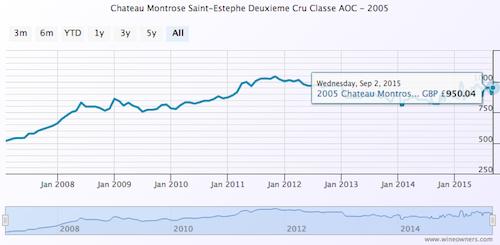
by Wine Owners
Posted on 2015-08-28
1/ Grand Puy Lacoste 2010 is a great wine. 4 years after release, the price is £100 off its opening price. GPL 2010 is surely now one of the buys of that wonderful vintage. Rated 95 points by Robert Parker this will be a magnificent drink in years to come. We would not be surprised to see this rerated 97 points in due course.
'An absolutely magnificent wine from this very popular estate, which sits well off the Route du Vin, just to the southwest of the town of Pauillac, its classic creme de cassis and floral notes are well-displayed. The wine possesses supple tannin, a full body, voluptuous character and a layered, impressively textured mouthfeel. This is a brilliant effort from Grand Puy Lacoste that can be drunk in 4-5 years or cellared for three decades or more.' RP 95.
- - -
2/ Montrose 2010 is another beauty, a perfect wine and less expensive than 2009, yet a seamless monument that is the equal of any of the First Growths. It’s hardly surprising this is a hot market: surely it’s only going to go one way from here?
'This is considered to be among the greatest vintages ever made in Montrose, right up with the 1929, 1945, 1947, 1959, 1961, 1989, 1990 and 2009. Harvest was October 15 to 17. The wine has really come on since I last tasted it, and it needs at least another 10 years of cellaring.' RP 100.
- - -
3/ Ducru Beaucaillou 2011 is interesting. It wasn’t so long ago that top new vintages of this super-second were releasing at well into 4 figures. The unfashionable 2011 vintage provides the opportunity to buy in for just £660 per case of 12.
Exchange activity is suggesting this is a buy as top-drawer drinking claret. The latest Parker score surely reflects the a period during which the wine has shut down. Once this wine starts to open up again, could there be the potential for it to be rerated in the 93-95 range in line with the en original primeur rating? Neal Martin’s rating is 92-94.
'The 2011 Ducru Beaucaillou (which normally represents 1/3 to ½ of the entire crop) possesses a dense ruby/purple color along with a beautiful nose of sweet creme de cassis, crushed rock and spring flower aromas. This rich, medium to full-bodied St.-Julien is among the most concentrated wines of the Medoc. Moderate tannin is sweet and well-integrated. This beauty will benefit from 3-5 years of cellaring and keep for two decades.' RP 92+.
